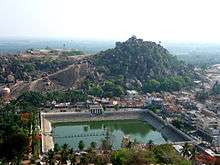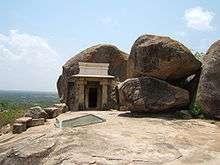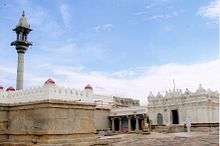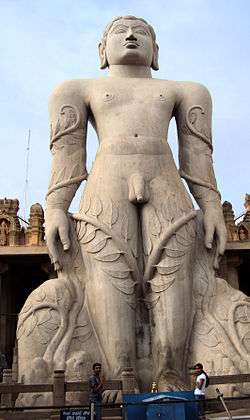Shravanabelagola
| Śravaṇa Beḷagoḷa ಶ್ರವಣಬೆಳಗೊಳ Shravanabelagola | |
|---|---|
| town | |
|
The statue of Gommaṭteśvara Bahubali dated 978-993 | |
 Śravaṇa Beḷagoḷa Shravanabelagola | |
| Coordinates: 12°51′32″N 76°29′20″E / 12.859°N 76.489°ECoordinates: 12°51′32″N 76°29′20″E / 12.859°N 76.489°E | |
| Country |
|
| State | Karnataka |
| District | Hassan |
| Time zone | IST (UTC+5:30) |
Shravanabelagola (Kannada:ಶ್ರವಣಬೆಳಗೊಳ Śravaṇa Beḷagoḷa) is a city located near Channarayapatna of Hassan district in the Indian state of Karnataka and is 158 km from Bangalore, the capital of the state. The Gommateshwara statue at Shravanabelagola is one of the most important tirthas (pilgrimage destinations) in Jainism, one that reached a peak in architectural and sculptural activity under the patronage of Western Ganga dynasty of Talakad. Chandragupta Maurya is said to have died here in 298 BCE after he became a Jain monk and assumed an ascetic life style.[1]
Location
Shravanabelagola is located at 12 km to the south-east of Channarayapatna in the Channarayapatna taluk of Hassan district of Karnataka. It is at a distance of 51 km south-east of Hassan, Karnataka, the district centre. It is situated at a distance of 12 km to the south from the Bangalore-Mangalore road (NH-48), 78 km from Halebidu, 89 km from Belur, 83 km from Mysore, 233 km from Mangalore, 17 km from Hirisave and 157 km from Bangalore, the capital of Karnataka.
Etymology
Shravanabelagola "White Pond of the Shravana" is named with reference to the colossal image of Gommaṭa - the prefix Śravaṇa serves to distinguish it from other Belagolas with the prefixes Hale- and Kodi-, while Beḷagoḷa "white pond" is an allusion to the pond in the middle of the town. The Sanskrit equivalents Śvetasarovara, Dhavalasarovara and Dhavalasarasa used in the inscriptions that support this meaning.
Some inscriptions mention the name of the place as Beḷguḷa, which has given rise to another derivation from the plant Solanum ferox (hairy-fruited eggplant). This derivation is in allusion to a tradition which says that a pious old woman completely anointed the colossal image with the milk brought by her in a gullakayi or eggplant. The place is also designated as Devara Beḷgoḷa "White Pond of the God" and Gommaṭapuram "city of Gommaṭa" in some epigraphs.
History

Shravanabelagola has two hills, Chandragiri and Vindhyagiri. Acharya Bhadrabahu and his pupil Chandragupta Maurya are believed to have meditated there.[2][3] Chandragupta Basadi, which was dedicated to Chandragupta Maurya, was originally built there by Ashoka in the third century BC. Chandragiri also has memorials to numerous monks and Śrāvakas who have meditated there since the fifth century AD, including the last king of the Rashtrakuta dynasty of Manyakheta. Chandragiri also has a famous temple built by Chavundaraya.
The 58-feet tall monolithic statue of Gommateshvara is located on Vindyagiri Hill.[4] It is considered to be the world's largest monolithic stone statue. The base of the statue has an inscriptions in Prakrutha i.e. devnagari script, dating from 981 AD. The inscription praises the king who funded the effort and his general, Chavundaraya, who erected the statue for his mother. Every twelve years, thousands of devotees congregate here to perform the Mahamastakabhisheka, a spectacular ceremony in which the statue is anointed with Water, Turmeric, Rice flour, Sugar cane juice, Sandalwood paste, saffron, and gold and silver flowers.The next Mahamastakabhisheka will be held in 2018. The Statue is called as 'Statue of Gommateshvara' by the Kannada people of Karnataka, but the Jains refer to the same as "Bahubali".
Inscriptions
More than 800 inscriptions have been found at Shravanabelagola, dating to various times from 600 AD to 1830 AD. A large number of these are found in the Chandragiri and the rest can be seen in the Vindhyagiri Hill and the town. Most of the inscriptions at the Chandragiri date back before the 10th century. These inscriptions include texts in the Kannada, The second volume of Epigraphia Carnatica, written by B. Lewis Rice, is dedicated to the inscriptions found here. It is said to be the oldest Konkani inscription.The inscriptions are written in various Halegannada (Old Kannada) and Purvahalagannada (Ancient Kannada) characters. Some of these inscriptions mention the rise and growth in power of the Western Ganga Dynasty, the Rashtrakutas, the Hoysala Empire, the Vijayanagar Empire and the Wodeyar dynasty. These inscriptions have helped modern scholars to understand the nature and development of the Kannada language and its literature.[5]
On August 5, 2007, the statue at Shravanabelagola was voted by the readers of Times of India as the first of the Seven Wonders of India.[6] 49% votes went in favor of the statue.
Basadi



1. Akkana Basadi: built in 1181 A.D. Akkana Basadi has twenty-third Jain Tirthankar (saint) Parshwanath as main deity of the temple.
2. Chandragupta basadi: established in 9th century.The middle cell of this temple has the figure of Parshvanatha, the one to the right the figure of Padmavathi and the one to the left the figure of Kushmandini, all in a seated posture.
3. Shantinatha Basadi:This temple is dedicated to Shantinatha.It was built around 1200 A.D.
4. Parshwanatha Basadi: This is a beautiful structure with decorated outer walls. The image of Parshwanatha is the tallest on the hill which is 18 feet in height. The manastambha (pillar) is sculptured on all four sides which contains the figure of Padmavathi on the south, Yaksha on the east, seated Kushmandini on the north and a galloping horseman on the west. The pillars in the navaranga are of round Ganga type with bell, vase and wheel mouldings.
5. Kattlae Basadi: This is situated to the left of Parshwanatha Basadi and in fact this is the biggest of all the Basadis on this hill.Kattlae Basadi has first Jain Tirthankar (saint) Rishabhnatha as main deity of the temple. Here one finds the image of Adinatha Thirthankara and also of Pampavathi in the Kaisale.
6. Chandraprabha Basadi: It is dedicated to the worship of the Eighth Thirthankara, Chandraprabha. The images of Shyama and Jwalamalini, Yaksha and Yakshi are to be found.The basadi is a brick structure raised over a stone base.This temple might be one of the oldest on the hill and its date would be about 800 A.D. It is said to have been constructed by the Ganga king Sivamara II.
7. Suparshwanatha Basadi: Seven headed serpent is carved over the head of the Suparshvanatha image.
8. Chamundarayaraya basadi: is the finest and one of the largest temples on the hill.It is dedicated to Neminatha, the twenty second tirthankara. The sukhanasi consists of good figures of Sarvahna and Kushmandini, the yaksha and yakshi of Neminatha.It is dated back to 982 A.D.
9. Chavundaraya Basadi: This Basadi was constructed in 982 by Chavundaraya. It is dedicated to the worship of Neminatha Swamy, the 22nd Thirthankara.This is constructed as the most beautiful of all the Basadis.
Other notable things
Shravanabelagola is the seat of the ancient Bhattaraka Matha, belonging to the Desiya Gana lineage of Mula Sangh, from the Digambara monstic tradition. The Bhattarakas are all named Charukirti. Bahubali College of Engineering is an educational institute at Śravaṇa Beḷgoḷa.
Prominent Personalities
- Charukeerthi Bhattaraka Swamiji, pontiff of the Shravanabelagola Jain Mutt
- S V Bhaskrachar, prominent leader
Photo Gallery
-

Aerial view of Shravanabelgola and vicinity, Karnataka
-

Chandragiri hill temple complex
-
Another view of the statue of Bahubali at Shravanabelagola
-

Gommateshvara Bahubali during Sunset
-

miniature version of the Gomateshvara statue
-

This photograph of Chandragiri Hill and Tank at Śravaṇa Beḷgoḷa, taken in the 1890s by an unknown photographer, is from the Curzon Collection's "Souvenir of Mysore" Album
-

Old Kannada inscription at the base of the Gomateshwara monolith in Śravaṇa Beḷgoḷa (981 AD Western Ganga Dynasty)
-

The pond in the middle of city, after which it is named, Beḷgoḷa “White Pond”
-

Bhadrabahu Cave
-

The steps leading to the summit of Vindhyagiri
-

Akkana Basadi
-

Chandragupta Basadi
-

Parsvanatha Basadi
-
Shantinatha basadi
-

Odegal Basadi
-

Aerial view of Gommateshvara statue
-

18 feet idol of Parsvanatha in Parsvanatha Basadi at Shravanabelgola
-

Bharatha Statue at Shravanabelagola
-

Gommateshvara statue
-

Mahamastikabhishek of Gommateshvara statue
-

Mahamastikabhishek of Gommateshvara statue
-

Mahamastikabhishek of Gommateshvara statue
.jpg)
See also
| Wikimedia Commons has media related to Shravanabelagola. |
Notes
- ↑ Vir Sanghvi, "Rude Travel: Down The Sages", Hindustan Times
- ↑ Sangave 2001, p. 204.
- ↑ S. Settar, Inviting Death: Historical experiments on sepulchral hill, Karnatak University, Dharwar, 1986
- ↑ "Delegates enjoy a slice of history at Śravaṇa Beḷgoḷa", The Hindu, Chennai, Staff Correspondent, 1 January 2006
- ↑ Introduction in Epigraphia Carnatica Vol.2 Institute of Kannada Studies, Mysore, 1972.
- ↑ "And India's 7 wonders are", The Times Of India, 5 August 2007
References
- Karnataka State Gazetteer 1983
- Rice, B. Lewis (1889), Inscriptions at Sravana Belgola: a chief seat of the Jains, (Archaeological Survey of Mysore), Bangalore: Mysore Govt. Central Press
- Sangave, Vilas Adinath (2001), Facets of Jainology: Selected Research Papers on Jain Society, Religion, and Culture, Mumbai: Popular Prakashan, ISBN 978-81-7154-839-2
External links
| Wikimedia Commons has media related to Shravanabelagola. |
-
 Shravanabelagola travel guide from Wikivoyage
Shravanabelagola travel guide from Wikivoyage - Article on Śravaṇa Beḷgoḷa
- The Bhattarakas of Shravanabelgola and Mudabidri